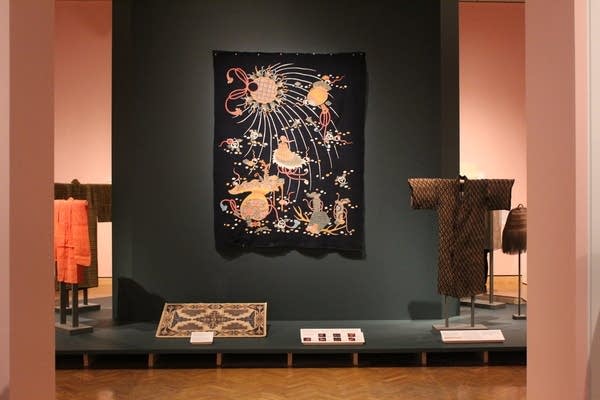Van Gogh and Japanese clothing: Two long-awaited exhibits open at MIA

Go Deeper.
Create an account or log in to save stories.
Like this?
Thanks for liking this story! We have added it to a list of your favorite stories.
Walking into “Dressed by Nature: Textiles of Japan” it’s hard not to notice that all the robes are displayed from the back. Curator Dr. Andreas Marks says this is on purpose.

Marks spent the last 11 years just getting to know the objects in the Institute’s large Japanese collection. Unlike typical garment exhibits, the clothing presented in “Dressed by Nature: Textiles of Japan” represent every class level in Japan over the period between 1750 and 1930. From things worn by farmers, common folk and workers to royal and ceremonial robes, Marks tried to emphasize the many different types of robes and textiles in Japan at the time.
“This is a great way for us to see how other people were living,” Marks said. “They harvested from their surroundings in order to create clothing. These days we just take it for granted to go somewhere and buy anything prefabricated and think it is normal, but it didn’t used to be like that.”

Materials such as fish skin, paper, elm bark, banana leaf fiber, deerskin, cotton, silk and more were used to create the textiles on display.
Turn Up Your Support
MPR News helps you turn down the noise and build shared understanding. Turn up your support for this public resource and keep trusted journalism accessible to all.
A vital aspect of the exhibit is the recognition of the Ainu people. They are native to Hokkaido, the northernmost of Japan’s main islands, the Kuril islands and the southern part of Sakhalin Island, which today belongs to Russia.
Until the mid 1800s, the Ainu people maintained their own culture and language but when they needed work, they were forced to hire out with the new Japanese fishing industry.
In 1871, the Japanese government banned some Ainu customs in an effort to erase their culture. The Hokkaido Former Aborigines Protection Act of 1899 was created to ‘integrate’ Ainu people into Japanese society by declaring them as former aborigines and removing any sense of Ainu from their lives. They were now farmers and forced to learn Japanese.

The Ainu Cultural Promotion law replaced the 1899 act over 100 years later in 1997. This law provides government financial support for the promotion and maintenance of the Ainu culture. In 2019, a bill in Japan recognized the Ainu as Indigenous people of northern Japan and banned discrimination against them
As of five years ago, only 13,000 people globally identify as Ainu, but less than a dozen are fluent in the native Ainu language. The textiles created by the Ainu people displayed in the exhibit aid to a larger movement by the Ainu to relearn weaving and embroidery to reclaim their culture nearly 150 years after it was erased.
Marks said he wanted to help tell the story of the Ainu people.
“The issue was making this all presentable to build a story,” he said. “It was not just about hanging stuff, but telling a compelling story that is interesting for people so I had to figure out all the different rooms and what I can do in there to set them apart.”

A quick walk across the second floor and visitors will find “Van Gogh and the Olive Groves.” The exhibition unites MIA’s treasured “Olive Trees” with five more paintings from the Van Gogh Museum in Amsterdam and the Dallas Museum of Art
Van Gogh painted the pictures in the last year of his life, when he spent some months in the psychiatric hospital in Saint-Rémy, France in 1889. Matthew Welch, MIA’s deputy director and chief curator, said the Olive Grove paintings differ from Van Gogh’s previous work because of his declining mental health.

“He was confined to the mental hospital for a period when he had a breakdown and did not paint,” Welch said. “From his window in the hospital, he could see a wheat field so when he finally was able to paint again, that was one of his first subjects. But when they started letting him wander further afield he started to visit the olive groves so in some ways, his confinement at the mental hospital sort of drove that choice of the subject matter.”
MIA’s “Olive Trees” is unique in the Olive Grove pictures due to its inclusion of the sun, often a symbol of spiritual beliefs. By the time he left the hospital in 1890, Van Gogh had completed 15 paintings of the groves. A few months later, he would commit suicide.

“When he leaves Paris and goes to the south of France for the light, it’s really painting in this very impressionistic style but increasingly he is descending into mental illness and that is where the final part of the exhibition picks up, with these olive grove paintings and in the rebirth,” Welch said.
Dressed by Nature: Textiles of Japan will run through September 11 and Van Gogh and the Olive Groves until September 18.


